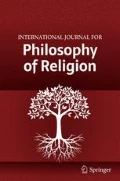Abstract
I will consider how the notion of incommensurability, as championed by Parfit (Reasons and persons, 1984), Griffin (Well-being: its meaning, measurement and importance, 1986), Chang (Ethics 112:659–688, 2002), and Hare (Philos Perspect 23:165–176, 2009), might affect both the argument from slight pain (which suggests God’s non-existence can be inferred from the merest stubbing of one’s toe) and Leibniz’s reply to this argument. I conclude that the notion of incommensurability may ultimately strengthen Leibniz’s general position.
Similar content being viewed by others
Notes
For an interesting discussion of these issues see Daniel Cohen’s paper ‘Creating the Best Possible World: Some Problems From Parfit’.
It should be noted that Leibniz’s overall aim is only to demonstrate that the existence of pain/evil is logical compatible with the existence of God, under these conditions.
Note that others have argued that states of affairs are not incommensurable. One competing explanation for our indecision in such cases is that we can’t judge one option to be better than another (before and after mild sweeting) because the values involved (or our measure of them) are vague—see Broome (1997).
My thanks to James Franklin, Daniel Cohen and Wylie Breckenridge for their help with this paper.
References
Broome, J. (1997). Is incommensurability vagueness? In R. Chang (Ed.), Incommensurability, incomparability, and practical reason. Cambridge: Harvard University Press.
Brown, C., & Nagasawa, Y. (2005). The Best of All Possible Worlds. Synthese, 143, 309–320.
Chang, R. (2002). The possibility of parity. Ethics, 112, 659–688.
Chang, R. (2005). Parity, interval value and choice. Ethics, 115, 331–350.
Cohen, D. (2009). Creating the best possible world: Some problems from parfit. Sophia, 2(48), 143–150.
Franklin, J. (2003). Leibniz’s solution to the problem of evil. Think, 5, 97–101.
Griffin, J. (1986). Well-being: Its meaning, measurement and importance. Oxford: Clarendon Press.
Hare, C. (2009). Perfectly balanced interests. Philosophical Perspectives, 23, 165–176.
Hick, J. (1966). Evil and the god of love. New York: Harper and Row.
Leibniz, G. (1952). Theodicy. (A. Farrer, Ed., & E. Huggard, Trans.). New Haven, CT: Yale University Press.
Luck, M. (2009). Aquinas’s miracles and the Luciferous defence: The problem of the evil/miracle ratio. Sophia, 48(2), 167–177.
Parfit, D. (1984). Reasons and persons. Oxford: Oxford University Press.
Author information
Authors and Affiliations
Corresponding author
Rights and permissions
About this article
Cite this article
Luck, M. Incommensurability, slight pains and God. Int J Philos Relig 75, 79–85 (2014). https://doi.org/10.1007/s11153-013-9416-3
Received:
Accepted:
Published:
Issue Date:
DOI: https://doi.org/10.1007/s11153-013-9416-3




